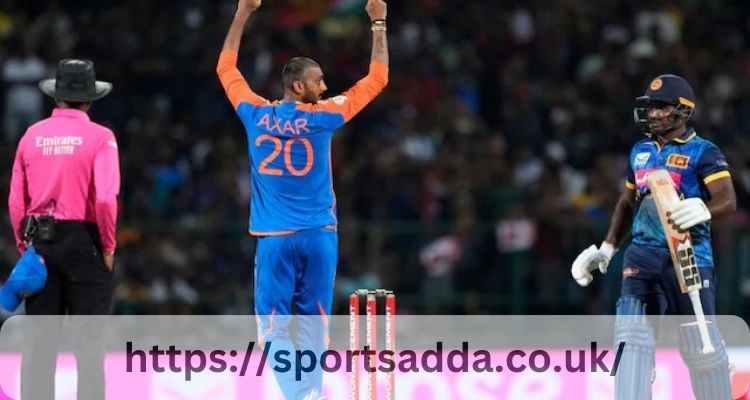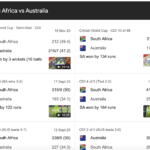Sri Lanka Vs India Matches – Four Key Aspects of Match Analysis
Sri Lanka and India are two of the greatest rivals in international cricket, producing some of its greatest moments and providing plenty of entertainment throughout their encounters.
As they batted first, the hosts amassed a respectable total with Avishka Fernando and Pathum Nissanka making half-centuries. Meanwhile, tourists were reduced to 138/6 in just 30 balls before Riyan Parag gave them an early LBW decision and broke their opening stand of 86 runs with an excellent LBW decision of his own.
To know more about Sri Lanka National Cricket Team vs India National Cricket Team Timeline just read the article.
Timeline
Sri Lanka sent shockwaves through Indian cricket on Tuesday in Colombo by producing exceptional batting and bowling performances at both ends of the ODI match at R Premadasa Stadium. Charith Asalanka’s men had suffered five consecutive series defeats at home against Indian opponents before unleashing some stunning cricket at this first one-day international. Dunith Wellalage especially was impressive on both fronts.
Rohit Sharma and Shubman Gill opened for India, immediately displaying some stunning hitting. Gill took control of proceedings by chipping a full-pitched delivery over mid-off for four before quickly reaching three figures with an onward cut shot past backward point. Rohit Sharma followed suit by lofting one over extra cover before chipping another delivery over long off field for six.
But India struggled to break free in their initial half of innings as spinners held back run rates; Washington Sundar’s fantastic bowling spell having an effect. When Sri Lanka reached their last 10 overs of their innings they lost two wickets quickly but continued their fightback and did not give in easily.
Avishka Fernando came within four runs of scoring his fourth One Day International hundred when he was dismissed by Riyan Parag, taking his maiden wicket and ending their innings with nine wickets on board.
India’s response began slowly but gained speed in the second half of their innings. Kuldeep Yadav bowled a slow first over before reaping his reward with an early wicket from Kuldeep Yadav’s next one; which drifted down leg and missed its target entirely before Kuldeep Yadav raced past square leg for four and reached 100 before being bowled by Asitha Fernando for 18.
Matches
Beginning February 25th, India and Sri Lanka will play three Twenty20 Internationals (T20Is) and two Test matches as part of an ICC Future Tour Program series that was moved forward following India’s loss to Sri Lanka 3-0 in Test matches. Gautam Gambhir will assume his first assignment as Indian T20I coach while Virat Kohli makes his comeback after an extended hiatus from international cricket.
India and Sri Lanka have met 162 times in ODI matches since 1950, with India dominating by winning 93 matches to 57 for an edge over their hosts. The 2019 India series will give both teams an opportunity to start their preparations for the 2023 World Cup tournament.
India will look to extend their winning streak while Sri Lanka seeks a comeback after suffering a 2-0 series loss. Their batting has struggled against the turning ball while their bowlers have done well to exploit conditions at Colombo’s R. Premadasa Stadium. Sri Lanka captain Chamari Athapaththu believes her side have nothing to lose and hopes to claim victory in match three of their group stage series with India.
Spinners have proven their worth in the ODI series between India and Sri Lanka, taking nearly twice as many wickets than their fast-bowling counterparts. Batting has struggled on slow pitches that present difficult batting challenges beyond mere technique; however, Indian batsmen have proven more nimble than their Sri Lankan counterparts in scoring more runs on the ODI circuit recently.
Sri Lanka will field an extremely reduced squad for their T20Is against Pakistan this month, without Pathum Nissanka, Avishka Fernando, Nishan Madushka, Dinesh Chandimal, Kusal Mendis, Sadeera Samarawickrama Kamindu Mendis Dasun Shanaka Wanindu Hasaranga Dunith Wellalage Maheesh Theekshana Chamika Karunaratne Matheesha Pathirana or Matheesha Pathirana all playing their usual parts in these matches against Sri Lanka’s opponents – hopefully giving more opportunity for Pathum Nissanka or Avishka Fernando to show themselves. The opening T20 will take place at Pallekele International Cricket Stadium this Saturday (start time TBD).
Scores
Sri Lanka have won their series against India with an astounding margin of more than 100 runs after an exciting victory, their first in 27 years against them in any bilateral series. Their top four batters proved dominant against Indian bowling while wickets fell regularly for them so that India never managed to post an acceptable total.
Live Score of India Vs Sri Lanka Match: It was an intense encounter, with both teams trading runs and wickets back and forth before Sri Lankan spinners finally proved too much for India to bear as they controlled proceedings from start to finish as India struggled for an edge against them.
New batsmen found it difficult to handle spinners at first, falling on their back feet more often. After some aggressive strokes from openers they eventually found their groove.
Rohit Sharma stood out and scored a brilliant fifty during this match. He used the ball well and even hit several boundaries before being dismissed for 50 by Sri Lanka’s bowlers. Unfortunately, however, Rohit was outclassed by both middle and lower order batsmen during this encounter.
Riyan Parag made his One Day International (ODI) debut, replacing Arshdeep Singh at the last moment when Bhuvan Chandran had to withdraw due to leg injury.
Every game, the pitch has become better, enabling batsmen to time the ball better while providing some turn. Spinners are trying hard to keep the ball away from the stumps while maintaining spin.
Nissanka attempts another slog sweep but encounters resistance on top, and Pant is there to take the catch.
Ama Kanchana attempts a big shot but Radha Yadav takes an easy catch at midwicket.
Match Analysis
Match analysis refers to the practice of reviewing data from past matches and training sessions to optimize future performances. It has become an increasingly common tool in sport, used by teams from universities to local rugby clubs alike. In this blog post I will examine four essential aspects of match analysis.
An analyst must first select which data they wish to evaluate. With limited time available for analysis, an analyst must prioritize which aspects need to be examined most thoroughly – this might involve looking at individual players or team weaknesses as examples. It can also be beneficial to examine data from previous matches so as to gain a sense of what worked and didn’t.
Assimilation of historical match data can assist analysts in recognizing patterns and forecasting how players will perform in future matches. It’s important to remember, though, that using only data from past matches alone may lead to misleading interpretations; an injury or weather condition could have affected team performances during previous games; it is therefore crucial that analysts use this type of analysis alongside other forms of information sources when conducting their analysis.
One of the greatest challenges associated with match analysis is dealing with its high degree of variability between matches. Although this can be difficult, several strategies exist that can help minimize this difference – standardizing game formats, comparing training days closely together and analyzing data across varying scales are among them.
India and Sri Lanka have met in 171 One Day International (ODI) matches, with India taking 99 wins to Sri Lanka’s 59 victories. Additionally, five Twenty 20 Internationals (T20Is) were played between them – all won by India.
Both teams possess talented batsmen, yet struggle to post high totals due to slow batting speeds that make gaining runs difficult. If India wants to win this series they must increase their batting speed quickly.


